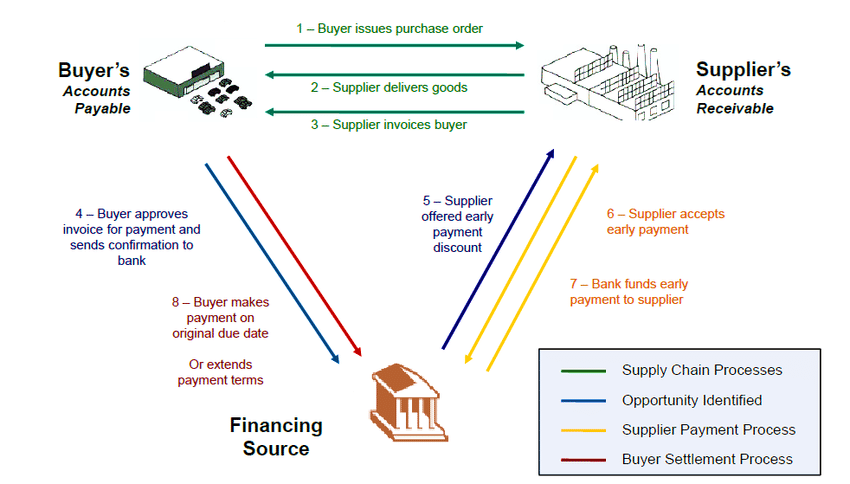How a Business can use Supply Chain Financing (Reverse Factoring) to increase working Cash flow
For decades, supplier financing has been reserved for the largest companies. Now it’s a cornerstone of a healthy, robust supply chain. As the end of the pandemic begins to materialize, many enterprises are looking to improve liquidity and achieve a healthier supply chain.
Supplier finance solutions enable companies to easily manage their working capital, and they’re now crucial for a robust supply chain. But to get the most out of even the best of this technology, companies must approach it with the right strategy. Working capital is critical to every business, but its importance is underscored in an environment that is inherently more susceptible to global and regional economic uncertainty, industry volatility, geopolitical changes, pandemics, man-made and natural disasters, and many other factors. To be considered high-performing, global supply chains must be agile, innovative, and competitive in spite of these variables – and all that’s fueled by working capital. Given these factors, it’s no surprise that finance and procurement professionals are seeking ways to more easily access working capital that is trapped in their supply chains.
Supply chain finance, also known as reverse factoring., links the seller, the buyer, and the financing party to improve business cash flow on all sides. According to Taulia Supply chain finance (or SCF) is a form of supplier finance in which suppliers can receive early payment on their invoices. Supply chain finance reduces the risk of supply chain disruption and enables both buyers and suppliers to optimize their working capital.
Key Takeaways
- Supply chain finance (or reverse factoring) can help boost a company’s working capital and cash flow, and create an ecosystem of growth as buyers and sellers work together.
- Unlike other receivables finance techniques like factoring, supply chain finance is set up by the buyer instead of by the supplier.
- Another key difference is that suppliers can access supply chain finance at a funding cost based on the buyer’s credit rating, rather than their own.
- As a result, suppliers are typically able to receive supply chain finance at a lower cost than they can otherwise access.
(image credit: Researchgate -Seifert, R. and Seifert, D., 2011)
How Supply Chain Financing Works
According to an article in American Express Business trends, suppliers can leverage supply chain finance solutions, to sell outstanding receivables to financial institutions to accelerate payment of receivables and extend payment flexibility to customers.
Once the supplier sends an invoice to the buyer, the buyer confirms to the financial institution that the invoice is approved and the supplier receives payment immediately. When the invoice is due, the buyer pays the financial institution back.
Supply chain financing company Taulia explains that “the buyer will enter into an agreement with a supply chain finance provider and will then invite its suppliers to join the program. Some supply chain finance programs are funded by a single bank or finance provider, while other programs are run on a multi-funder basis by technology specialists via a dedicated platform.”
Once a supply chain finance program is up and running, suppliers can request early payment on their invoices. From there, the supply chain finance process looks something like this:
- Buyer purchases goods or services from the supplier
- Supplier issues their invoice to the buyer, with payment due within a certain number of days (e.g., 30 days, 60 days, or 90 days)
- Buyer approves the invoice for payment
- Supplier requests early payment on the invoice
- Funder sends payment to the supplier, with a small fee deducted
- Buyer pays the funder on the invoice due date
Benefits for Buyers Using Supply Chain Financing
There are a few benefits for buyers using supply chain financing, including increased liquidity, less contentious relationships with suppliers, decreased liabilities, and consolidated finances.
- Optimize working capital – Buyers can also improve their liquidity and working capital position with supply chain finance, as many companies choose to implement supply chain finance programs in conjunction with an initiative to harmonize supplier payment terms.
- Improve supply chain health – By offering suppliers supply chain finance, buyers can reduce the likelihood of a future supply chain disruption that could affect their own operations.
- Strengthen supplier relationships – Buyers can improve their relationships with suppliers by providing them with access to low-cost funding and maybe in a stronger negotiating position as a result. In dealing directly with a supply chain funder (i.e. the factor), buyers can usually avoid payment disagreements with suppliers.
- Decrease liabilities – Buyers want to reduce liabilities so they can procure lower interest rates from lenders and maintain overall financial health. Using reverse factoring, the factor is on top of invoices and payments so buyers can focus on other things.
Benefits for Suppliers Using Supply Chain Financing
Supply chain financing isn’t just beneficial for buyers. Sellers also benefit from supply chain finance in the form of more reliable payments, lower interest rates, less time spent on accounting and more credit options.
- Optimize working capital – By accessing supply chain finance, suppliers can receive payment for their invoices earlier than they would otherwise. As a result, their days sales outstanding (DSO) is reduced, resulting in working capital improvements.
- Access lower-cost funding – The cost of funding is usually lower for suppliers than it is if they use other sources of funding, such as factoring, making supply chain finance an attractive way of obtaining funding. In a reverse factoring agreement, the interest rate offered by the financier is lower than in other arrangements. This is because it’s determined by the buyer’s credit rather than the supplier’s rating.
- Improve cash forecasting accuracy – When suppliers access supply chain finance, they may gain more certainty over the timing of incoming payments, making it easier to forecast their future cash flows accurately.
- Less time spent on accounting – Suppliers may spend hours per week following up on invoices and negotiating payment terms with buyers. When organizations engage in supply chain finance and factoring companies take over many of the administrative headaches, business owners can spend less time on accounting and more time strategizing for growth.
How to Set Up Your Business for Supply Chain Finance
Is supply chain finance for you? You can make an informed decision by considering your or your buyer’s size, investigating new technologies, researching and selecting the right vendor, and onboarding participants.
Consider Size
Supply chain finance is better for larger and possibly global buyers since these organizations tend to have stronger credit. The stronger the credit, the more likely you are to secure a helpful factoring agreement.
Investigate New Technologies
Looking to the future, several technological advances are making the supply chain finance proposition even more compelling. For example, blockchain helps with transaction transparency and authentication, while artificial intelligence is helpful for more accurate credit scoring.
Research Vendors
If you’re a buyer, you are responsible for selecting a supply chain finance vendor. You should look for financial institutions with experience in your industry that have worked with similar supply chains. The chosen vendor should offer a robust software platform for invoice management.
If you’re a supplier, you might discuss the potential for supply chain finance with your larger customers, since they must initiate the process.
Onboard Participants
Once they’re set up with a supply chain financier, buyers must invite suppliers to join the program, and suppliers who accept must complete an onboarding program that ensures all parties will work together seamlessly. Try to make the process as non-complicated as possible.
Supply chain finance is an excellent strategy to improve working capital and cash flow for buyers and sellers alike. Consider the advantages and take steps to put it to work for your business today.
Conclusion
While supply chain finance and dynamic discounting are two separate solutions, some companies may wish to access both types of programs. For example, some businesses will have surplus cash available at certain times of the year, which can be deployed in a dynamic discounting program – but at other times of the year, they may wish to invest the cash elsewhere.












